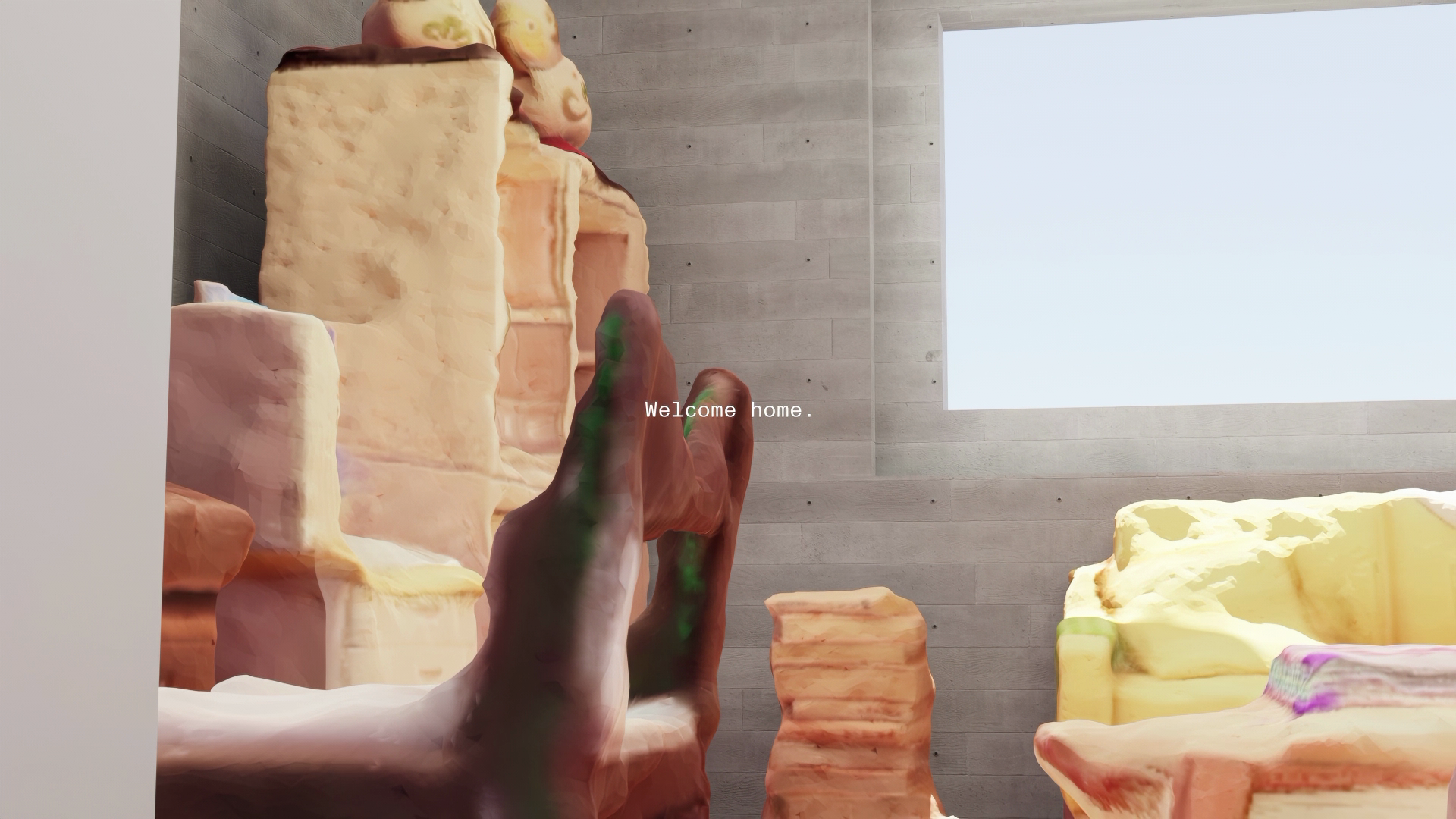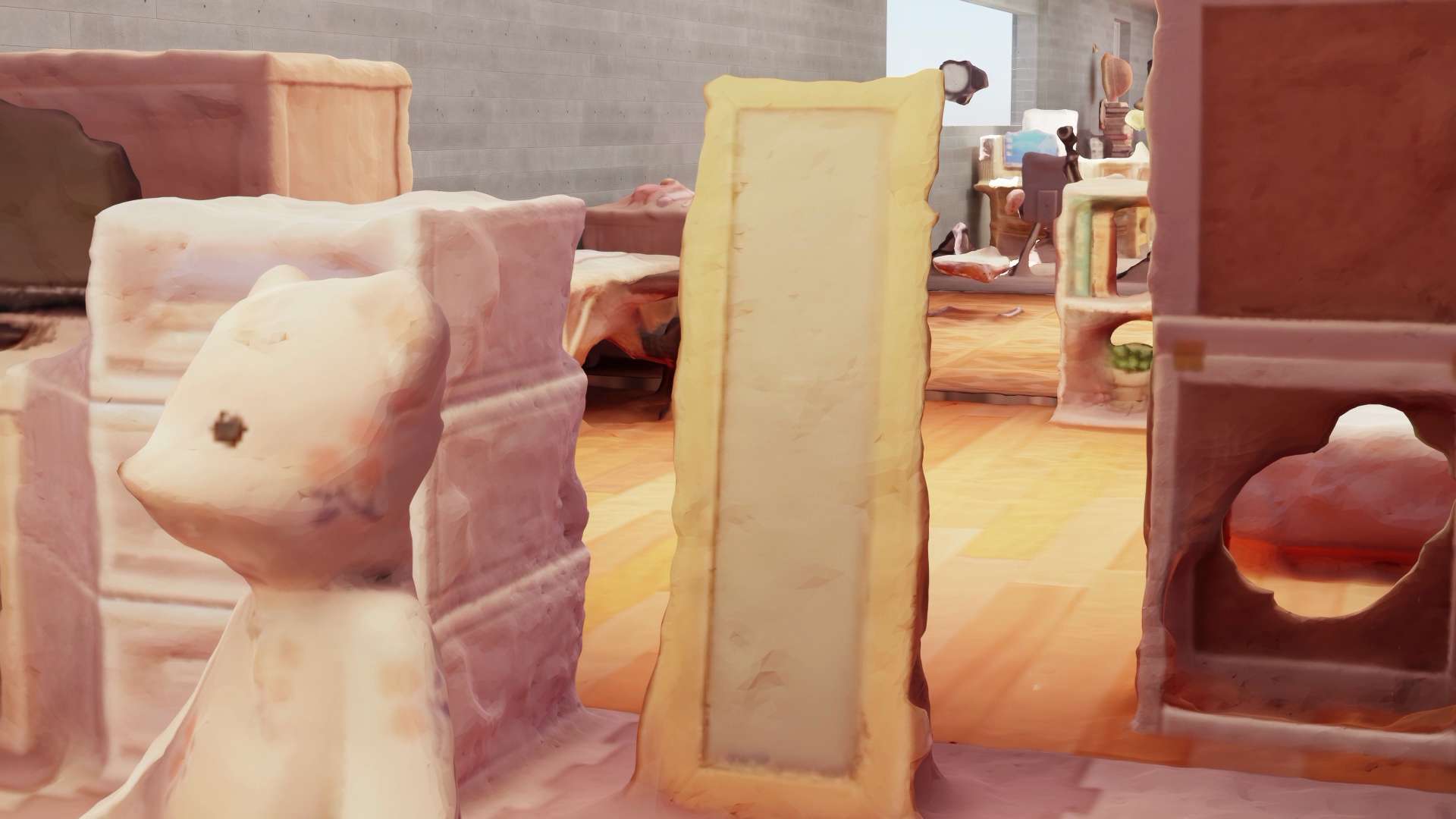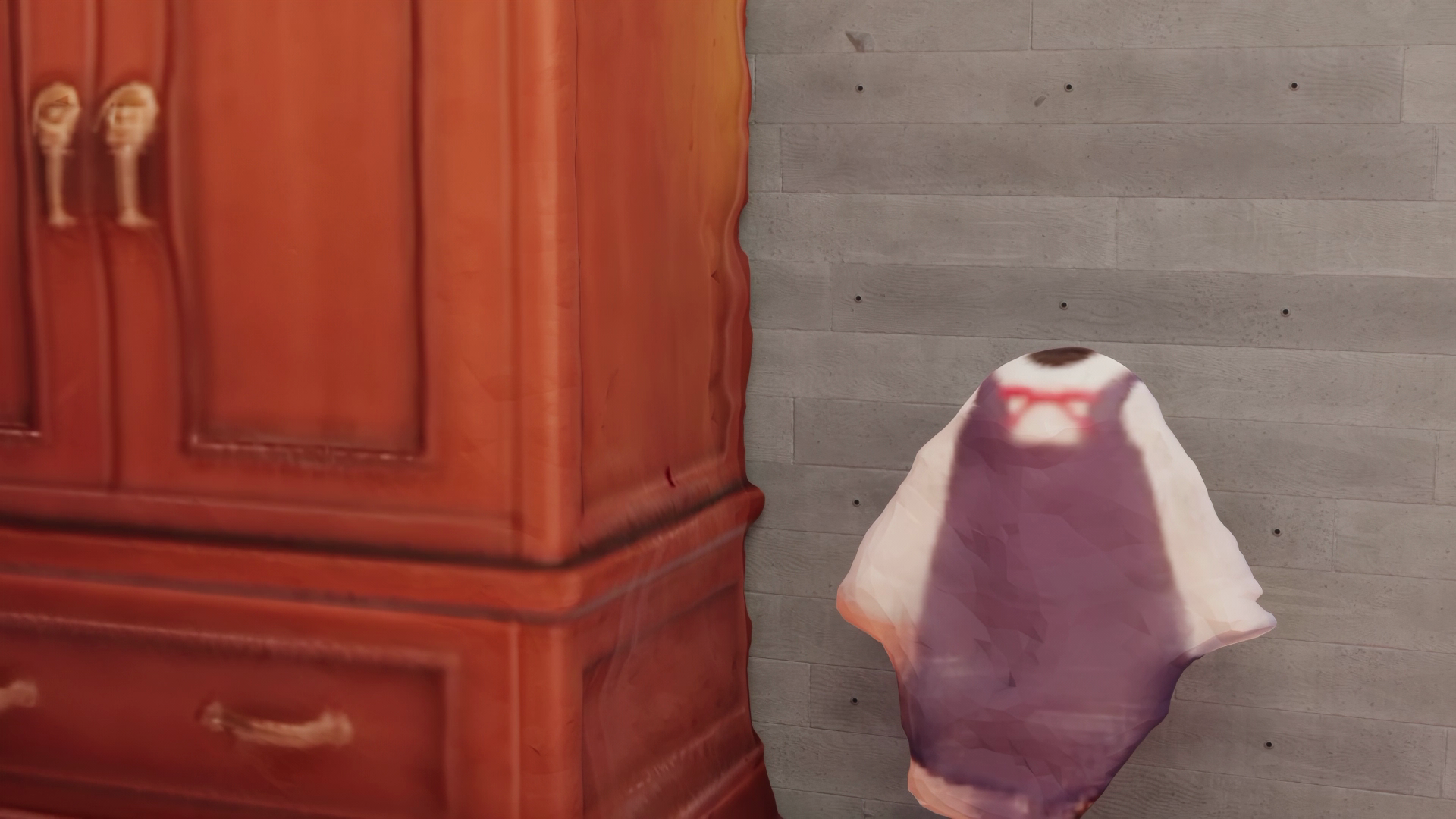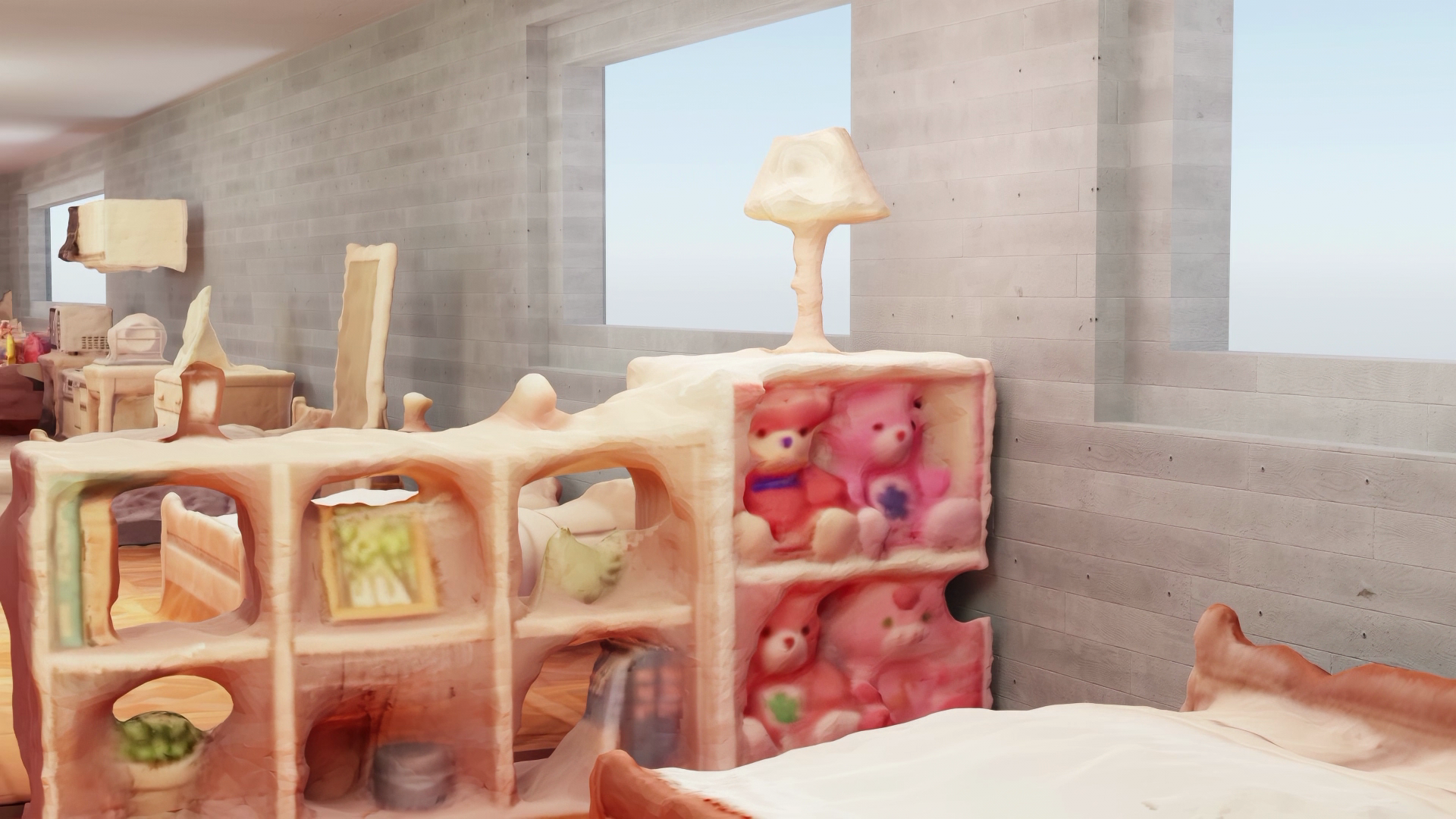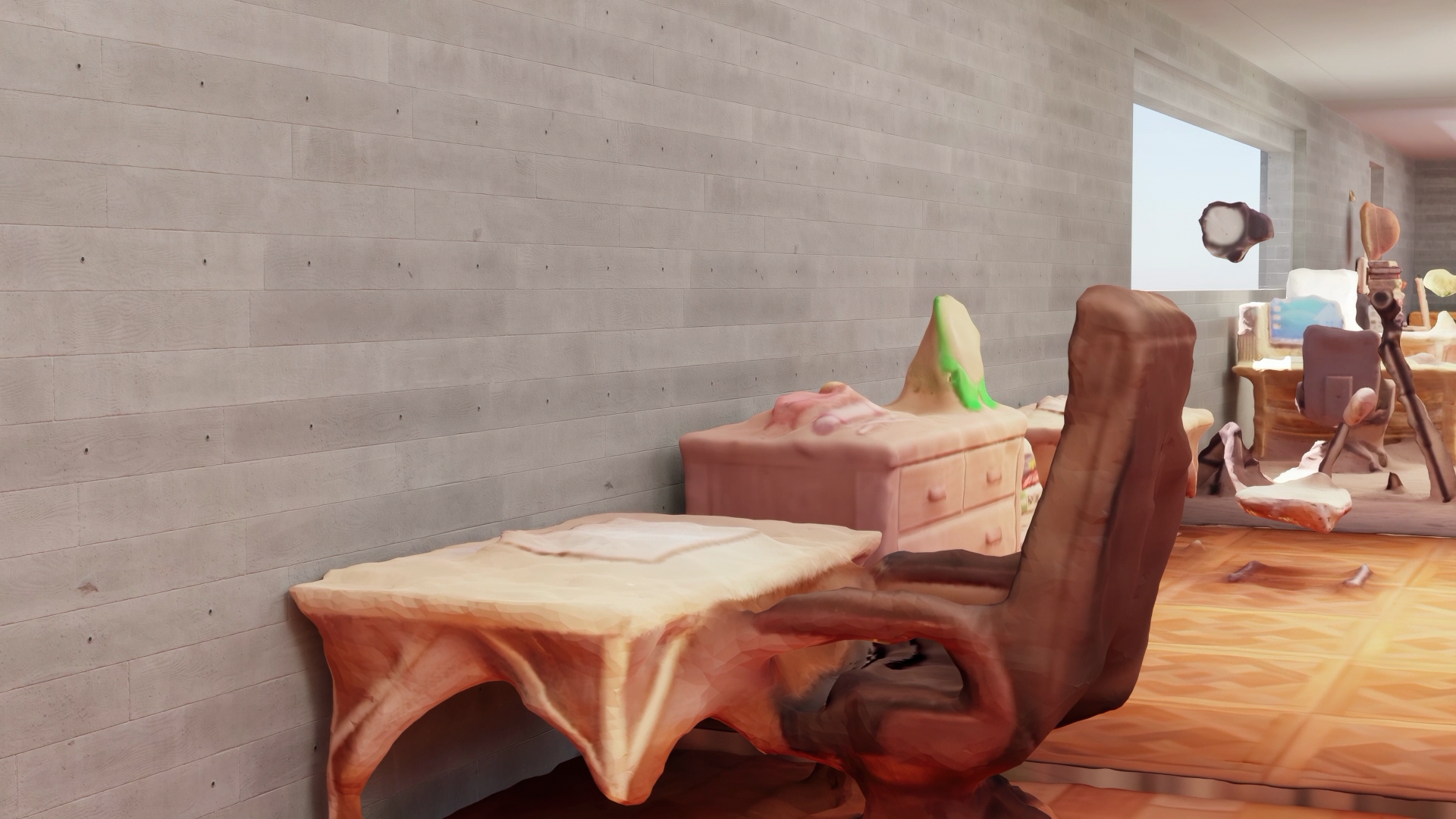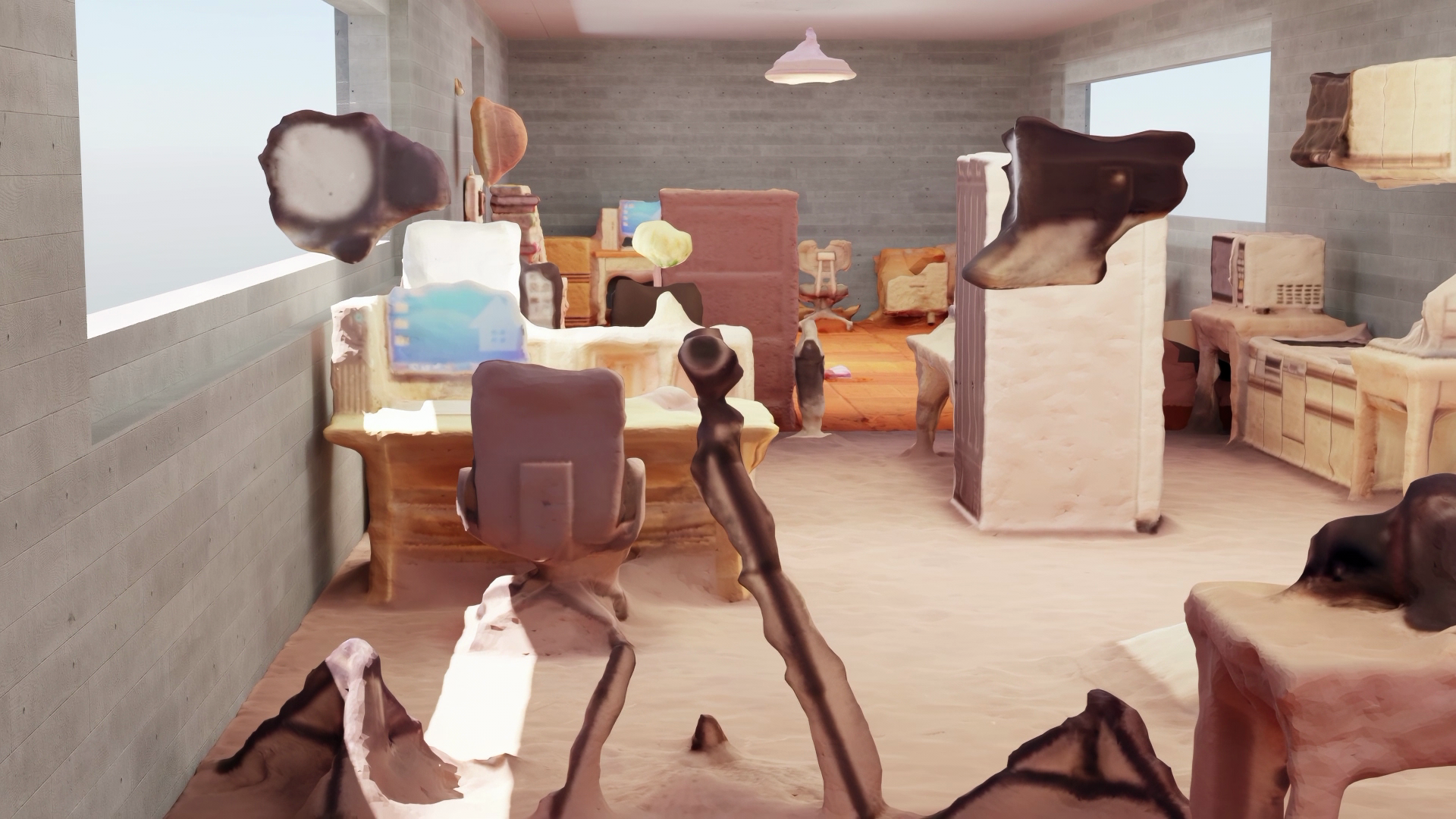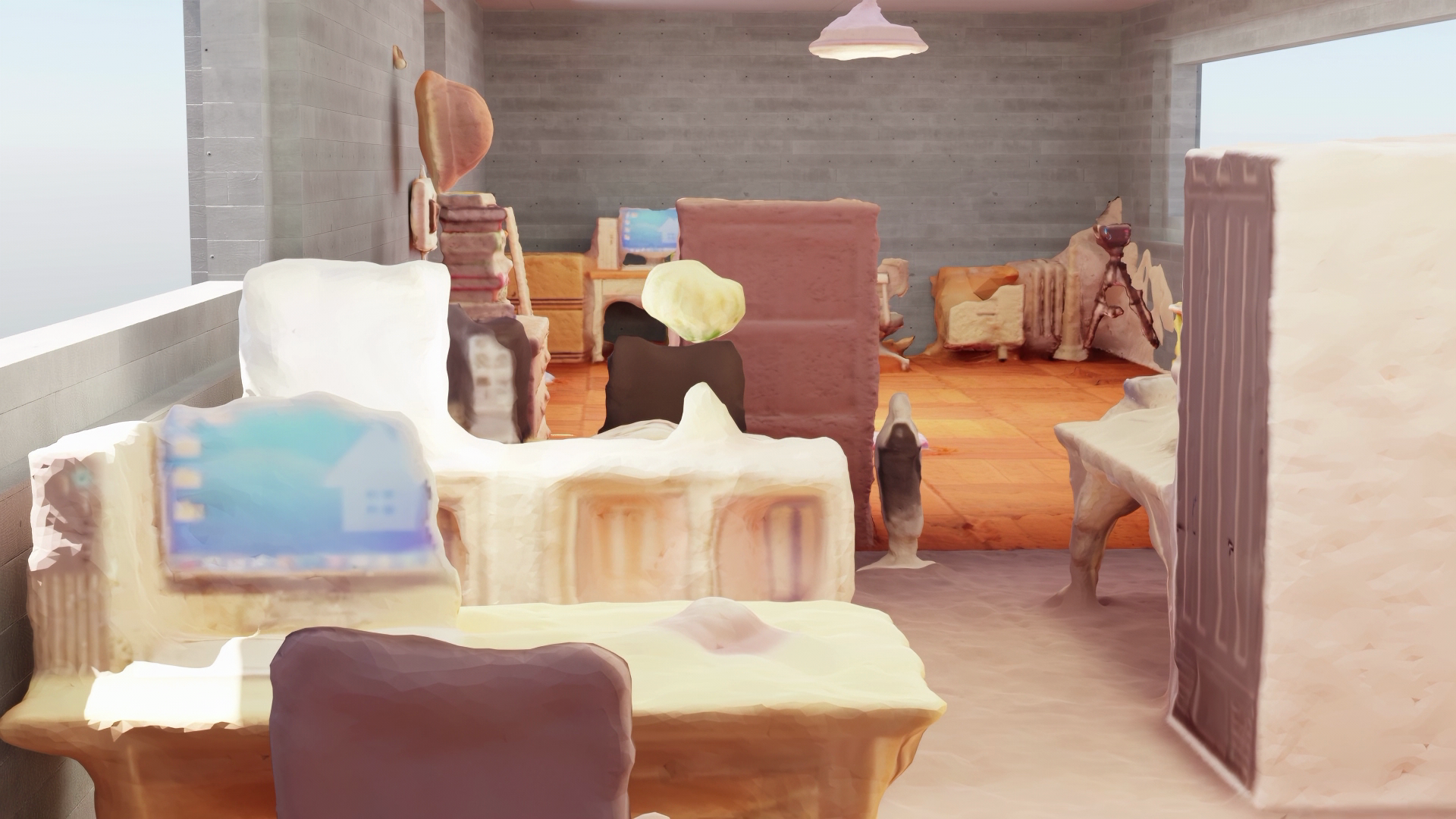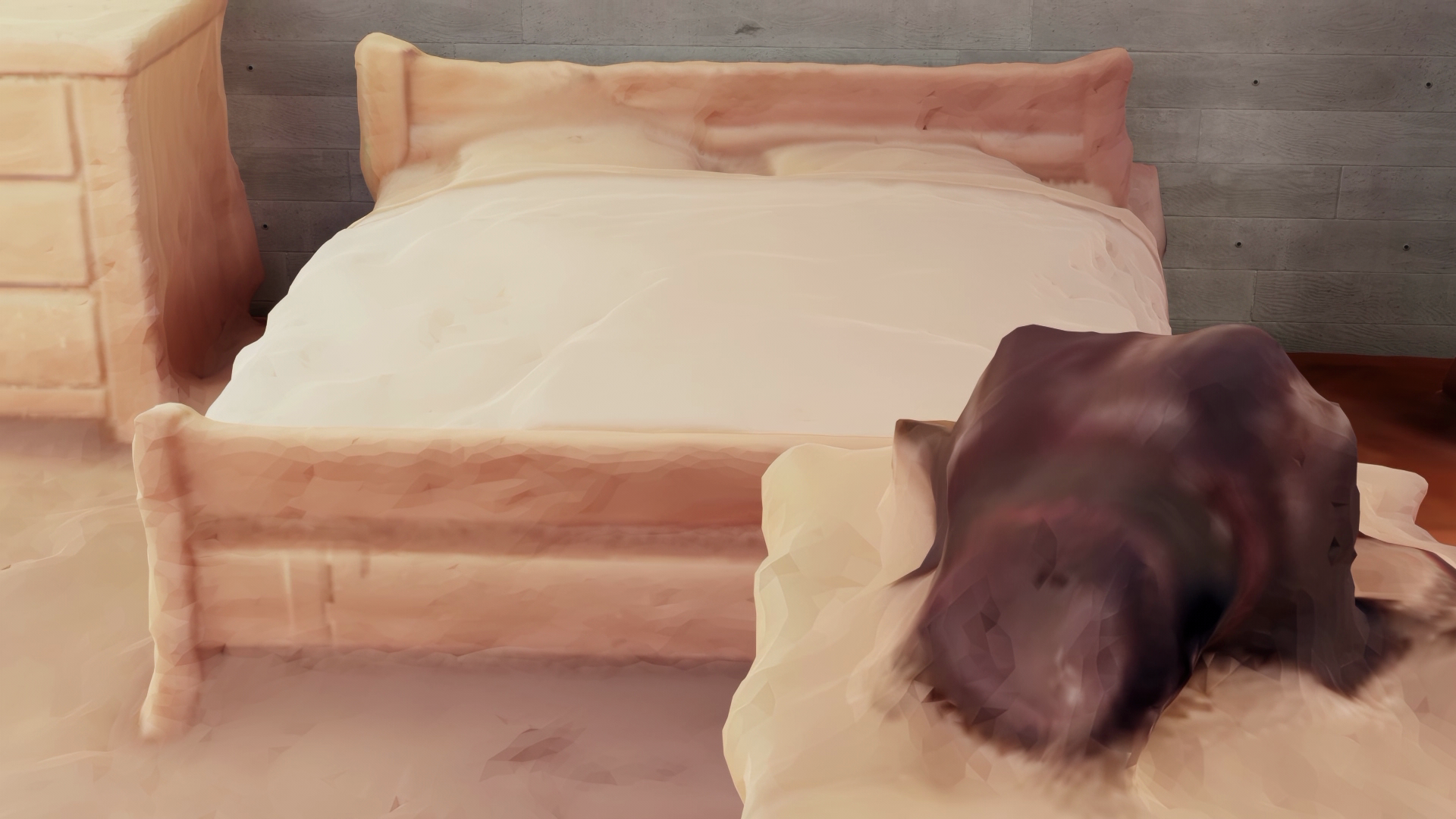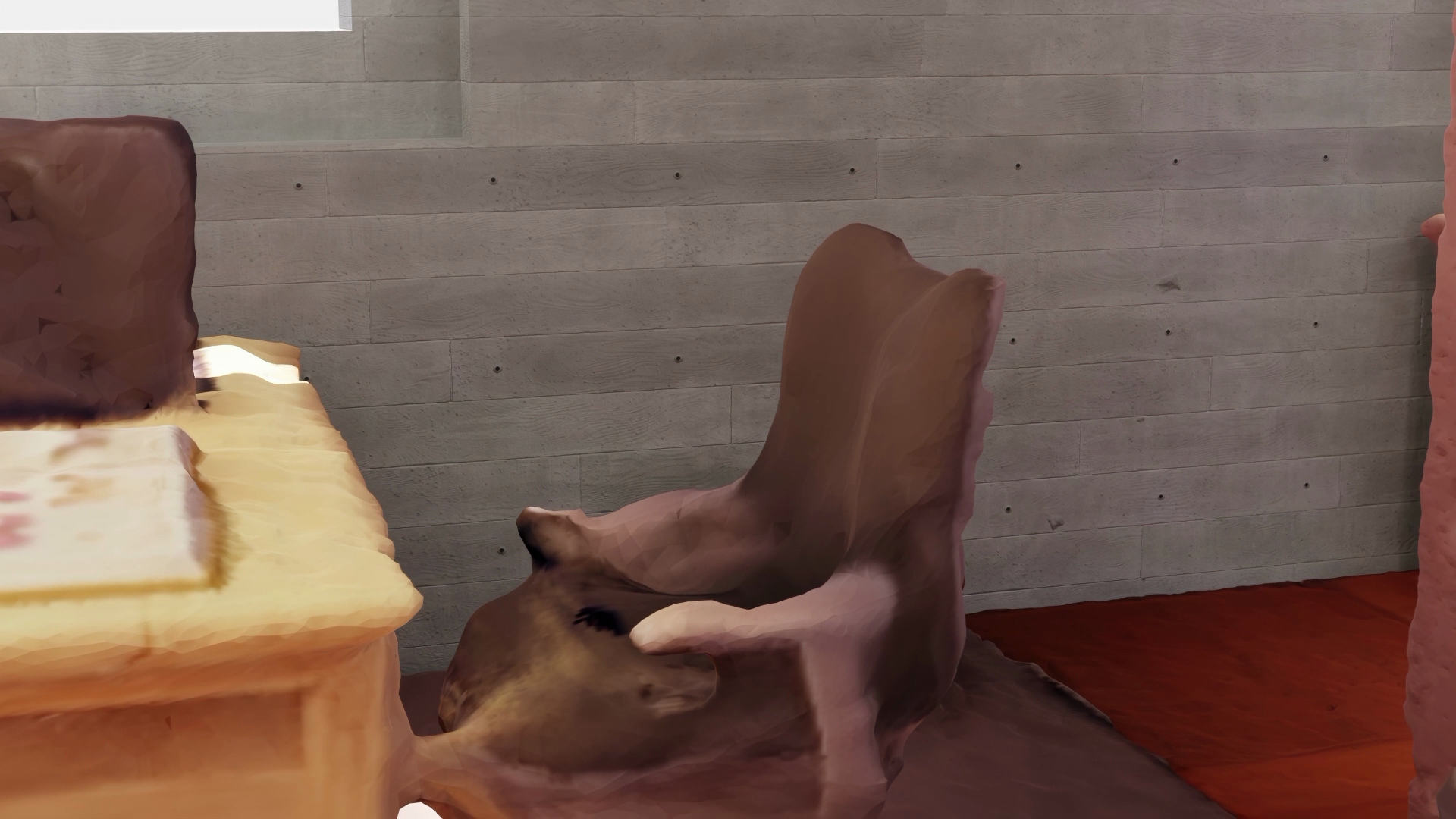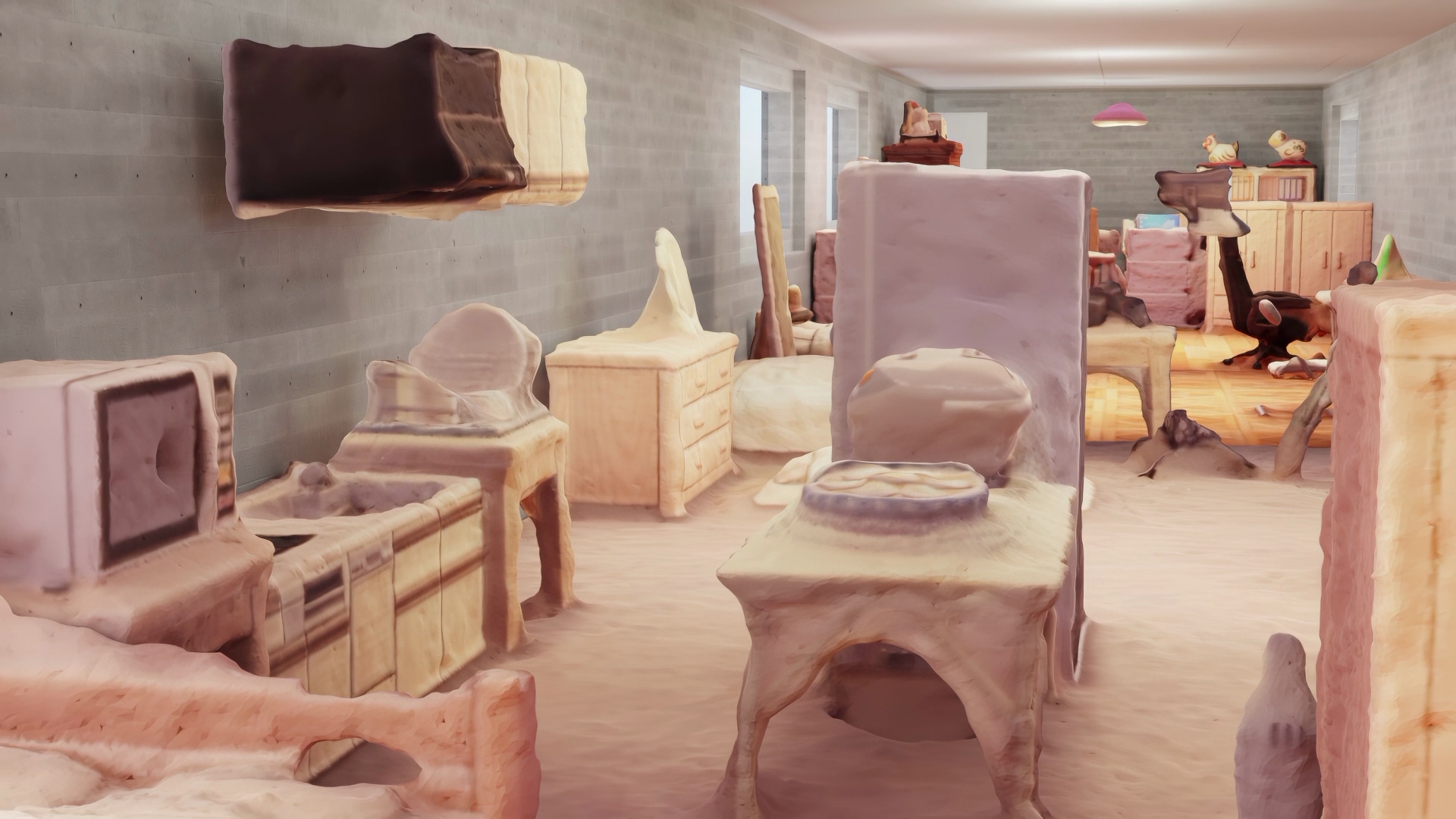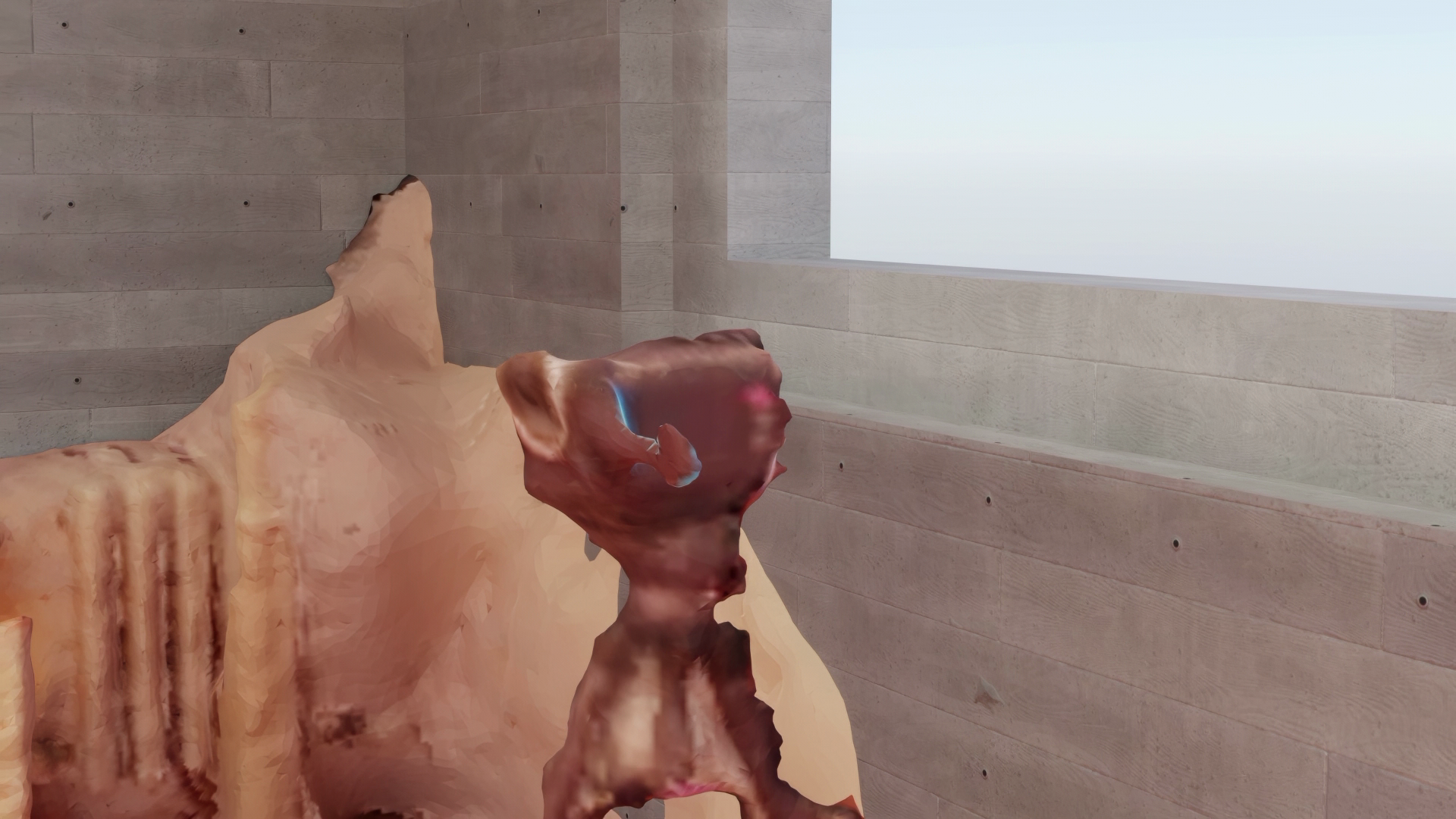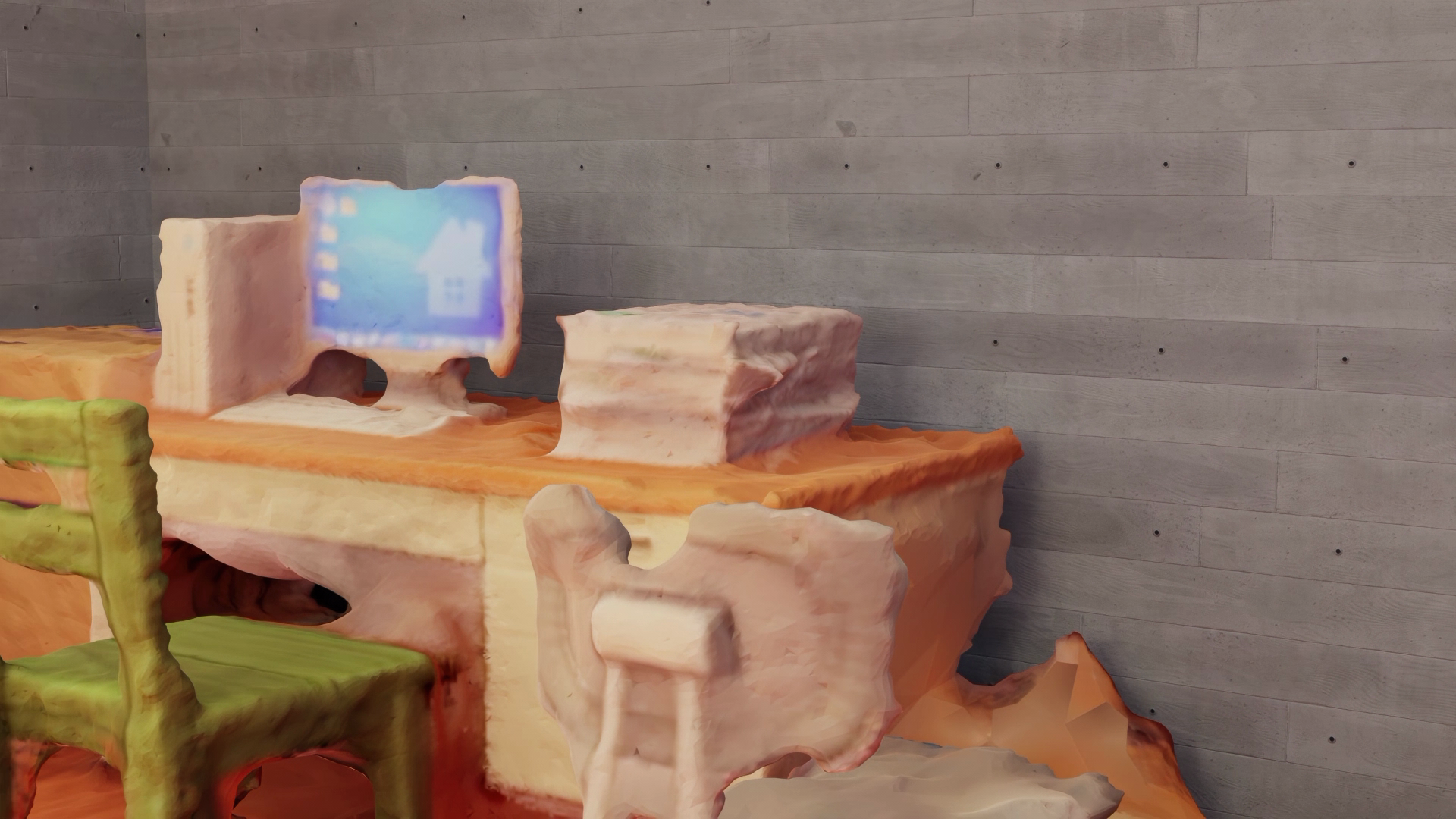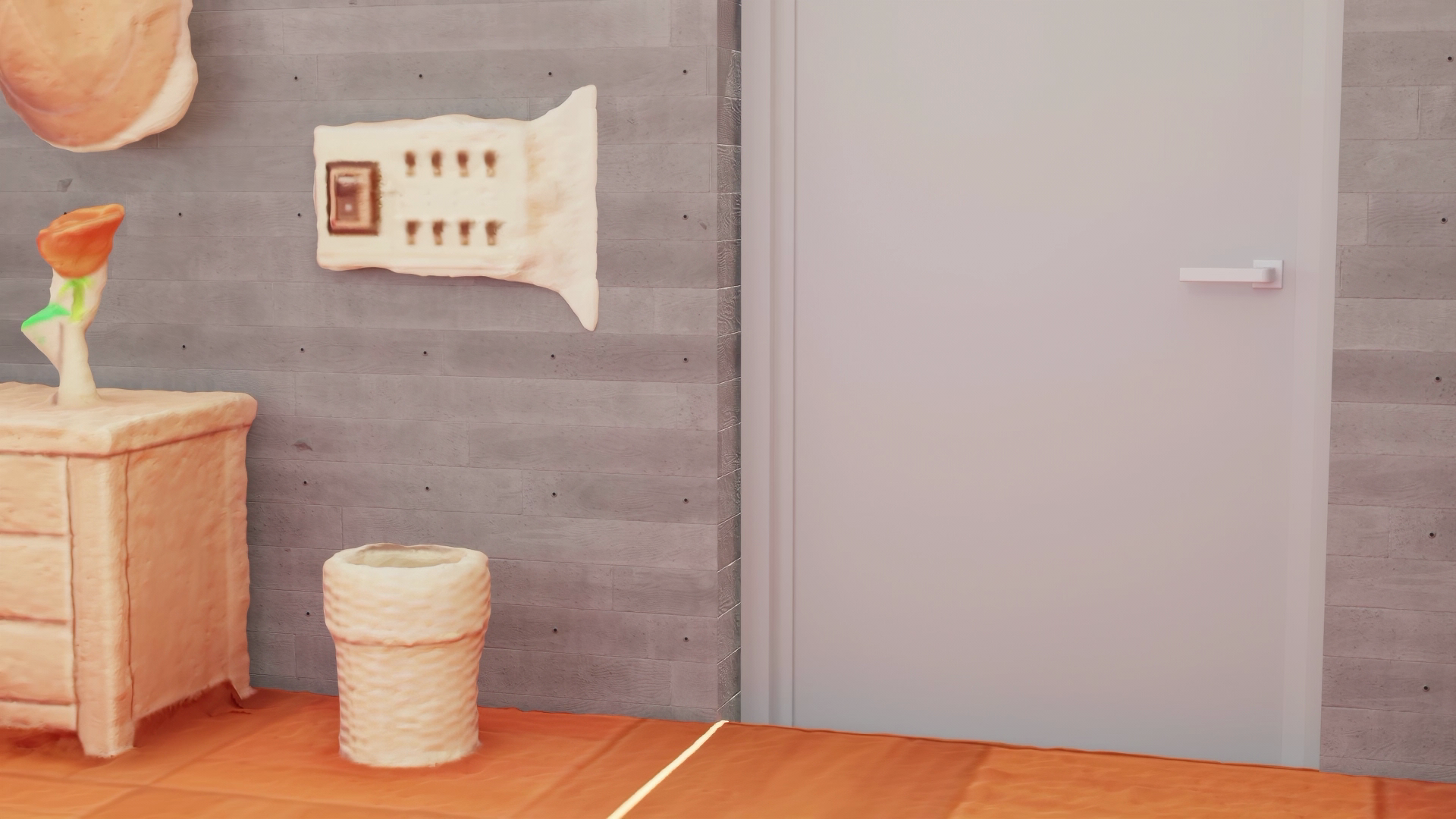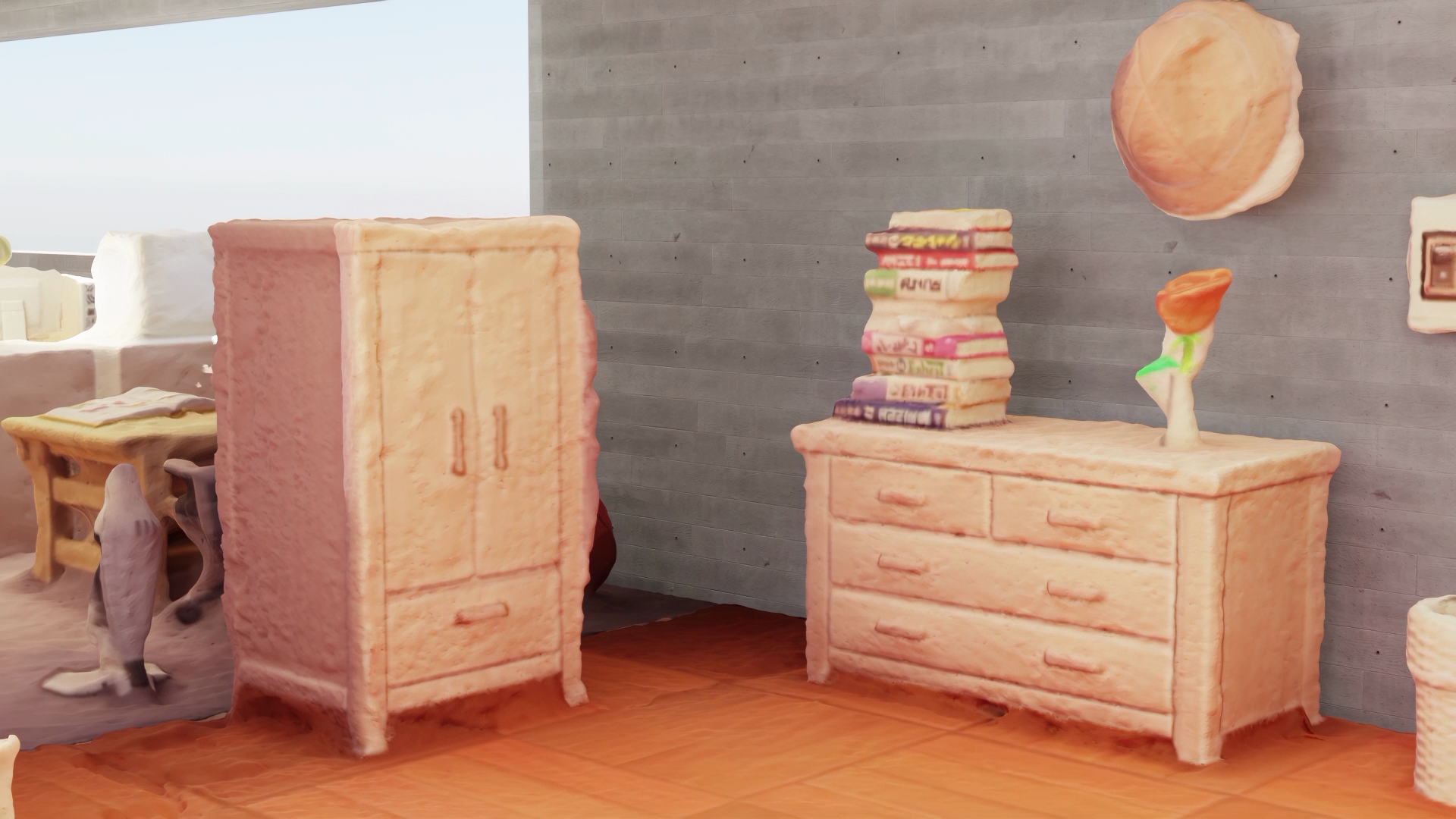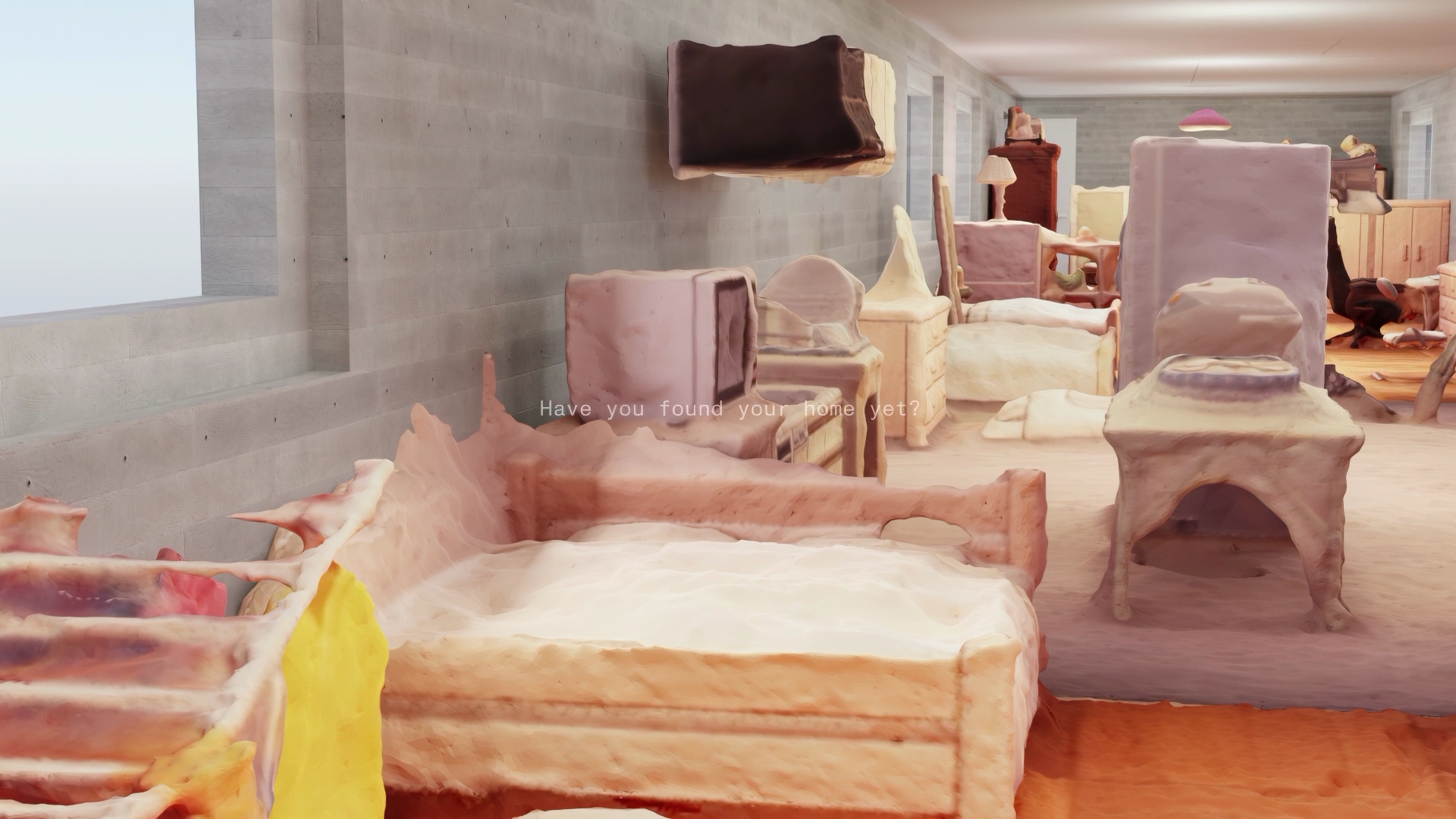HOME SWEET HOME
machinima/digital video, color, sound, 2’ 35”, Japan, 2023
Created by Fumi Omori
Home Sweet Home explores personal memories and their translation into physical architecture through Animal Crossing: New Horizon. With a history of frequent relocations, the artist captured their rooms in photographs, preserving emotional connections to past spaces. Animal Crossing, a beloved game providing an idyllic refuge during the Covid-19 pandemic, allowed the artist to craft personalized rooms reflecting their personality. This project questions the impact of translating real-life spaces into the virtual realm. Employing photogrammetry, the artist reconstructs their past homes in the game, blurring boundaries with imaginative architecture. The interplay between virtual and physical layers offers a fresh perspective, showcasing a unique visual hacking method. Automating realities on the virtual plane reveals the intricate relationship between our fragile understanding of reality and memories. Digital reverie becomes an avenue for escapism, confronting the present, future, nostalgia, and denial.
Fumi Omori navigates the crossroads of the cultural diaspora with her transcendent visual language. Currently nearing the culmination of her master’s degree in photography at the esteemed École cantonale d’art de Lausanne (ECAL) in Switzerland, Omori’s diverse experiences serve as a potent source of inspiration. Born and raised in Japan, the artist spent over a decade living in prominent American coastal cities (New York, Los Angeles, San Francisco) before gravitating towards the medium of photography. Her previous stints as a perceptive graphic designer and discerning art director have indubitably permeated her artistic vision.
Matteo Bittanti: Could you delve into your personal connection with the medium of video games, specifically focusing on Animal Crossing: New Horizons? I’m interested in understanding how the dynamic, two-dimensional, and somewhat abstract virtual architecture of video games intersects with your understanding of domestic spaces and inhabited environments.
Fumi Omori: I would say that the personal connection with the medium of video games itself started during my childhood in Japan. Nintendo, PlayStation, and other portable gaming devices like Bandai’s Tamagotchi were always present, and fortunately, I was graced with understanding parents who did not seem to mind my gaming proclivities. I vividly remember playing the original Animal Crossing, released in 2001. However, when I moved to America after completing primary school, I didn’t engage much with video games until 2020 when the pandemic hit. This unexpected situation prompted a resurgence of my gaming fervor. It was during this unforeseen period of quarantine that I found myself irresistibly drawn to procure a particular game — an ostensibly innocuous decision that would unfurl into an astonishing commitment of over 500 hours, as I meticulously crafted my very own virtual utopia upon an ethereal island.
At a subconscious level, I discovered an undeniable appreciation for the architectural intricacies woven into the fabric of this abstract two-dimensional realm, one that afforded me an unparalleled realm of exhilaration and boundless freedom. While the virtual universe offered by the game may reside outside the realm of tangible reality, its resonance with my authentic desires and aspirations resonated profoundly within me.
Within Home Sweet Home, a kind of epiphany takes places, unveiling a perception of spaces as innately transitory, impermanent, and evanescent in nature. This perspective raises intriguing questions about the nature of existence and emotional attachment. By documenting rooms through photography before departing from them, does one perceive this act as the exclusive means to validate their existence and bestow substance upon one’s emotional connections? Moreover, how does this process of preservation through photography interweave with the concept of impermanence and the elusive essence of our lived experiences within these spaces?
The project originated while I was casually flipping through the photo album on my iPhone, stumbling upon pictures of my previous homes and apartments just before I moved out. It struck me that over the course of my life, I had inhabited approximately 14 different places. Initially, my intention was to validate the existence of my own memories and to preserve the emotional attachments I had to these spaces I once called “home.”
In this contemplative process, I discovered that by capturing these moments through photography, I could give a tangible form to my memories. The act of documenting, or perhaps more aptly, preserving, became a way to navigate the fluid interconnection between the reality of these homes and my own physical transformation as I moved from one place to another. It was as if I sought to comprehend the inherent impermanence of my elusive experiences of “home” at some point in my life—a blueprint emphasizing the significance of existence itself.
Matteo Bittanti: Could you elaborate on how Animal Crossing: New Horizons became a kind of refuge from reality fro you, providing a sense of security and peace amidst the Covid-19 pandemic? Specifically, I’m interested in understanding how the act of crafting an ideal world on an a fantasy island allowed you to detach from the challenges of the real world. It prompts me to ponder whether we turn to digital games primarily to construct alternatives to a concrete reality that increasingly feels gravely compromised, if not failed. In essence, do you think that we increasingly rely on virtual fantasies as a means to endure the contingent aspects of everyday life in the 21 century? If this is the case, can the virtual realm transcend mere escapism and become the main pursuit imbued with something resembling genuine meaning?
Fumi Omori: It evokes a similar delight to adorning a personal room with furniture that harmonizes with a person’s unique taste, culminating in the creation of a space that mirrors one’s identity — a haven for unwinding, finding solace, and fostering a sense of security. In the realm of Animal Crossing, the passage of time seamlessly merges with elements drawn from our capitalistic society. Crafting your ideal island necessitates accumulating a significant sum of in-game currency, propelling me into the realm of real-life trading with fellow players and even sharing island prices on Twitter. As I delved deeper into these pursuits, I eventually ascended to the status of a virtual billionaire within the game, an achievement that comes as no surprise given my aforementioned investment of over 500 hours in gameplay.
Moreover, the game offers an extensive array of items for sale, including furniture and clothing, representing diverse cultures and current trends. It’s fascinating how Animal Crossing caters to the fantasies of our 21st-century society, providing endless possibilities for creating everything from peaceful island retreats to bustling cyberpunk metropolises or even simulations of iconic cities like Tokyo or Paris. One particular feature that inspired me was the introduction of the “dreaming” mechanic. By sleeping on your in-game bed, you can visit other players’ islands through public dream addresses. I stumbled upon dream islands that replicated the vibrant cities of Tokyo, Paris, and Hong Kong. It evoked a sense of tourism and instant happiness, granting me the opportunity to experience multiple virtual cities—a feeling we all sought during the pandemic as a form of escapism from being confined to our rooms.
Matteo Bittanti: Within Home Sweet Home, memory itself is called into question as a means of preserving the past. By engaging in the act of reconstructing past homes and infusing them with imperfect memories through the medium of impossible architecture within Animal Crossing, your work challenges our conventional understanding of the relationship between our “lived” experiences and those encountered on the screen. Both realms, despite their inherent differences, hold a profound sense of reality and significance for us. They are obviously both real. In light of this, I would like to ask you how this interplay between the tangible and the virtual blurs the boundaries of our perception. How does it influence our understanding of what is real and meaningful to us? Furthermore, could you elaborate on the ways in which your project prompts us to reconsider the value and authenticity of our experiences, considering the profound impact that both the physical and virtual realms can have on our lives? How does Home Sweet Home challenges the traditional dichotomy between the “real” and the “screen- based,” forging a deeper understanding of our experiences? I apologize for my verbose framing of this question, but there are so many angles…
Fumi Omori: For me, the concept of “home” holds a unique and temporal significance. Even when I am physically in my home, I am acutely aware that nothing is permanent and that I will eventually leave. This temporal aspect shapes my personal experience of home. The homes I constructed for this project represent some of the most memorable places I have lived, yet they are also the homes I can never return to. However, within the realm of Animal Crossing, the game itself becomes a personal space where I can establish a sense of “home” that encompasses both my reality and ideal. It was crucial for me to reflect upon and observe my memories and reconstruct them in a space where impossible architecture becomes attainable — a place where I could, in a sense, be simultaneously present in all the homes I have ever lived in. Initially, I didn’t focus on the idea of the screen as a means of preserving memories from reality. Rather, my primary focus was on my personal connection to the platform of Animal Crossing. This game provides a platform for diverse and unique expressions, and its fixed angles allow for the use of illusions to create impossible architectural designs. What is intriguing is that these impossibilities arise from the pursuit of realism within the game. Thus, I found it fascinating to construct a world that is not real but based on the game’s nature, providing a means to explore my relationship with the concept of “home.” In a way, you could say that I created a personal space that exists between the realms of the ideal and reality—a space where my memories and aspirations converge.
Matteo Bittanti: How did you approach the incorporation of postcards in your project, considering the parallels it draws to On Kawara’s renowned artwork, I Got Up? I found the juxtaposition between the immediate, interactive, and dynamic nature of the virtual realm and the deliberate slowness associated with snail mail — not to mention the materiality of the cardboard itself — to be especially thought-provoking in awn age of real-time communication, evoking a powerful sense of cognitive dissonance. Could you expand on your intentions behind this juxtaposition and how it contributes to the conceptual depth of your artwork?
The inspiration for creating postcards stemmed from my experience with Animal Crossing’s “dreaming” system, which evoked a sense of travel and exploration. I sought to capture the essence of “sending a postcard” from my own memories. In the video, I positioned myself as an observer, delving into the blurred recollections of my past and engaging in introspection and speculation. The act of creating these postcards became a result of self-observation, drawing parallels to On Kawara’s I Got Up series and incorporating elements of a tourist’s perspective. The juxtaposition within my work arises from the transformation of virtualized memories, ephemeral by nature, into tangible and physical postcards. The complexity lies not only in the interplay between these layers of memories, but also in the interrelation and intersubjectivity that emerges within the least technical texture of photography itself. Through this project, I aimed to experiment with striking a balance between the fragile formation of memories through escapism from reality and the realistic methods of preservation.
In essence, my intention was to explore the intricate dynamics at play between the ethereal nature of memories in a virtual space and the tangible representation of these memories through postcards.
Matteo Bittanti: I’d like to delve deeper into the techniques employed in your project, particularly photogrammetry and the projection of layers of reality onto the virtual realm. These processes seem to provide a distinct vantage point from which to explore personal memories. Could you expand on how these methodologies offer a fresh and unique perspective on the interplay between our lived experiences and the virtual worlds we construct and experience? Furthermore, I’m intrigued by the concept of visual hacking within the game system. How does this manipulation challenge traditional boundaries and provide new avenues for artistic expression? Does this kind of meta-play allow for the artistic experimentation that is basically negated by conventional gameplay?
Fumi Omori: Photogrammetry served as a valuable tool for both documenting and visualizing the diffusion of “ideal assets” into tangible memories within this project. Through this technique, I aimed to establish a deeper connection with my own memories. The scanning process was crucial in capturing a comprehensive three-dimensional representation of the architecture, requiring me to scan from multiple heights in a 360-degree manner.
In Animal Crossing, I pondered whether I could leverage some of the inherent features of the game to manipulate the visual system. Interestingly, the camera feature emerged as a significant tool for users, enabling them to record their islands and share their experiences online. It played a vital role in preserving memories of interactions with villagers, capturing moments like birthday parties, socializing with friends who visited their islands, and documenting the beautiful landscapes. When constructing homes based on my memories, the process felt different compared to traditional home-building. The nature of the game constrained my creativity to some extent, as I was reconstructing memories rather than engaging in pure creative expression.
The visual aesthetic of Animal Crossing is characterized by its distinctive cuteness and animated style, rather than striving for photorealism. By employing a meta approach to photographing the game, I aimed to convey and acknowledge that the resulting images embody someone’s imperfect memory. In essence, I sought to envision and emphasize the notion that these images encapsulate the essence of memories in an imperfect and subjective manner.
Matteo Bittanti: Is there anything you’d like to add? Please feel free to mention other projects of yours if they could contribute to clarify your fascinating approach. What are you working on these days?
Fumi Omori: I am currently working on a project in the exploration of multicultural identity and its intricate relationship with the notion of home within the immersive realm of virtual reality. This ambitious undertaking remains inextricably intertwined with the project we have been engaged in. By meticulously curating “self-portraits” of avatars, I endeavor to investigate the deeper connections and nostalgic sentiments intertwined with the yearning to belong in a broader context that transcends individual essence. For this purpose, I have crafted cyber avatars that encapsulate my cultural identities as Japanese, Korean, and Korean American. My aspiration is to bring this project to fruition within the allotted timeframe.
HOME SWEET HOME
machinima/digital video, color, sound, 2’ 35”, Japan, 2023
Created by Fumi Omori, 2023
Courtesy of Fumi Omori, 2023
Made with Animal Crossing: New Horizons (Nintendo, 2020)
Soundtrack: Berceuse, Op. 57 by Ivana Gavrić
Special thanks to Marco De Mutiis


